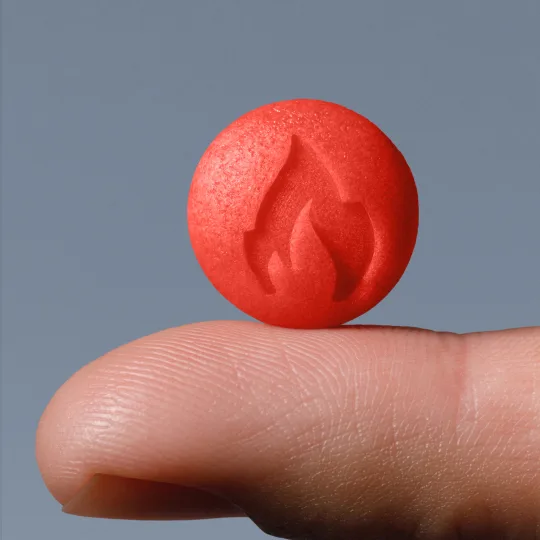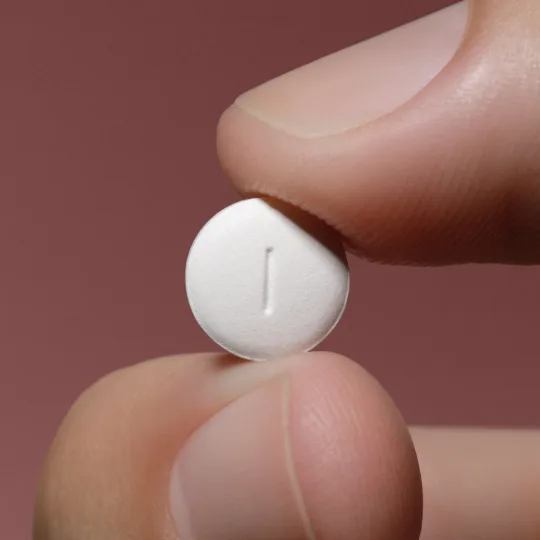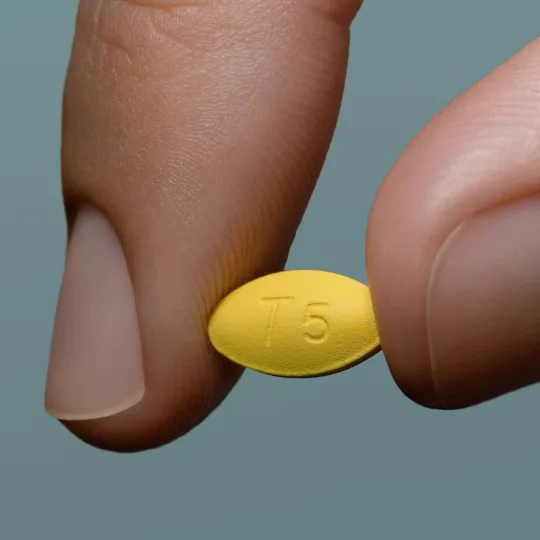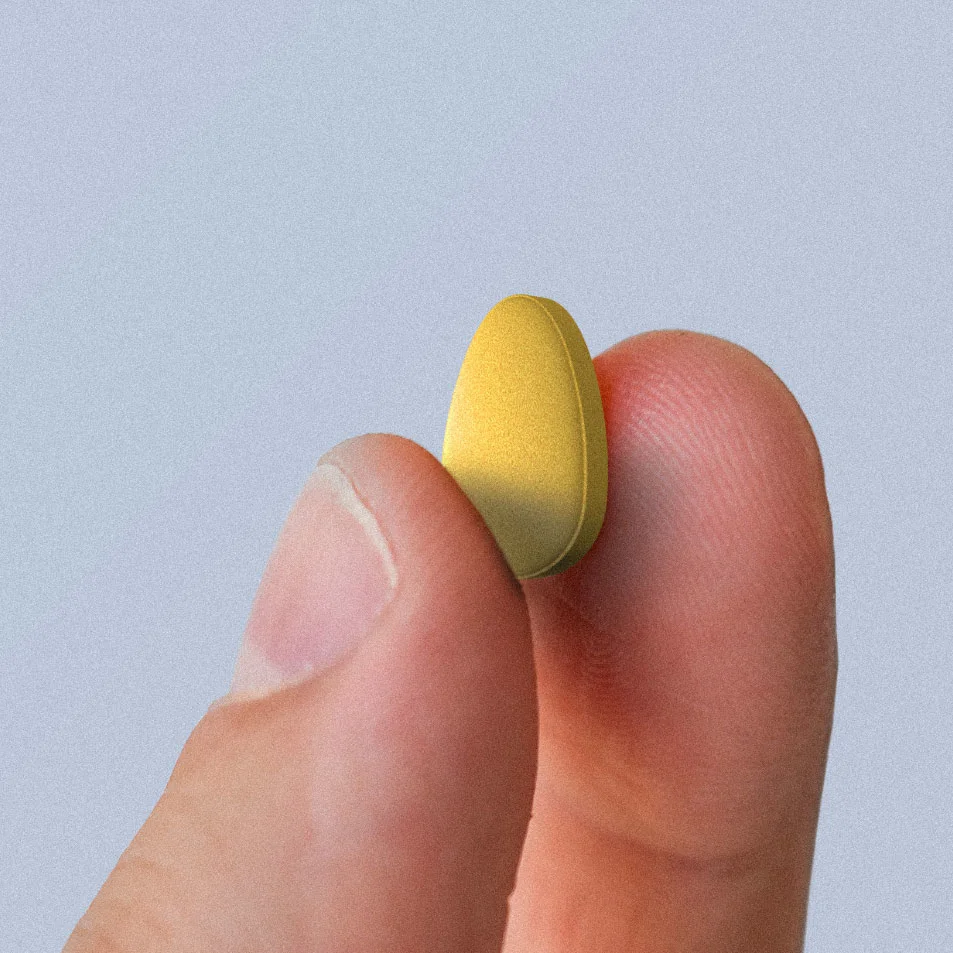Here's what we'll cover
For many guys out there, penis size is a very common concern, and some may even have anxiety about the size of their penis. What many men don’t know is that besides having a perfectly normal penis, the size of their penis seems to matter more to them than anyone else: One large study showed that 85% of women are satisfied with their partner’s penis size.
Still, you might wonder if it is possible to make your penis bigger. Well, here’s the hard truth: Besides undergoing surgery and using penis implants, most treatments out there aren’t going to increase the size of your penis, no matter what wild claims their ads might make. A quick Google search will show you advertisements for pumps, pills, and weights that claim to increase the length and width of your penis, there's very little scientific support for these nonsurgical methods to enlarge the penis.
Here are the most common procedures and devices that claim they can make your penis bigger—many of which come with some severe risks. Keep reading to learn more.
1. Increase penis length with surgery
With penis enlargement surgery, a surgeon cuts the ligament that attaches the penis to the pubic bone, increasing the perceived length of the penis.
Is this procedure recommended? Not according to Seth Cohen, MD, a urologist with NYU Langone Medical Center in New York City, who frequently sees patients expressing concern about their penis size and asking about penis enlargements.
"The suspensory ligament suspends the penis just like the suspension on a bridge. If you cut the suspensory posts on a bridge, the bridge will lag lower," says Cohen. "But I really don't recommend it because your erection will never point north again."
The research backs up Cohen’s view on these surgeries—satisfaction rates aren’t high, and most surgeons will only recommend these procedures in the rare case of a true micropenis.
2. Increase penis girth with surgery
Some providers offer surgery to increase penis girth. There are two primary approaches used.
One approach is for a patient’s own fat to be injected into their penis in order to achieve an increase in girth. These procedures aren’t generally recommended because they haven’t been shown to be very effective and can carry risks.
Another approach is when a substance like AlloDerm—sterilized tissue harvested from cadavers—is wrapped under the skin of the penis like seaweed in a sushi roll, resulting in a girth increase. This is considered to be an "off-label” use— AlloDerm is approved for burn therapy and reconstructive surgery, not penis enlargement, though healthcare providers can use a medication or device for unapproved purposes if they believe it is in the best interest of the patient.
There are reports in the medical literature of complications like infection and skin necrosis when AlloDerm is used for penis augmentation.
3. Penis injections
To enhance girth, some doctors inject temporary cosmetic fillers into the penis, similar to the fillers used on lips, brows, and smile lines to plump them up.
"I've never done this, but I've seen them done a few times," says Cohen. "It really depends on the substances you use. Restylane and Juvederm are tried-and-true substances we use as fillers on cheeks, chins, and different areas in the body. They usually last around six months and get absorbed into the body. They're not really tried-and-true tested on the penis. We just don't have any data to say it works long-term."
There is a significant potential downside to shooting fillers into your penis. "The penis is a very vascular organ, full of smooth muscle and spaces that hold blood," says Cohen. "If you fill one area, it may look very blotchy in another area. So you get this sort of lumpy, bumpy effect that is probably not what people are looking for."
4. Penis implants
Permanent penis implants placed under the skin of the penis have been available for decades for men with ED that don’t respond to the usual treatments.
In 2004, the FDA approved Penuma, a penile implant. for cosmetic enhancement. The cost of the procedure varies from clinic to clinic but typically falls between $16,000 and $18,000. A study of 400 patients who received Penuma implants found that they experienced an average of 56.7% increase in girth. At long-term follow-up (2-6 years), 81% of participants reported "high" or "very high" satisfaction. 3% of participants experienced complications that required the implant to be removed.
A number of urologists now offer the procedure, but not every urologist will recommend a penis implant for enlargement. "Penile implants are appropriate in men who have erectile dysfunction that doesn’t respond to more conservative therapies," says Landon Trost, MD, a urologist with the Mayo Clinic in Rochester, Minnesota. "The issue with penile fillers or implants is that they have many side effects. Fillers and Penuma are generally not recommended by the far majority of sexual medicine specialists."
Side effects of implants can include sexual dysfunction, infection, penis deformities, and more. More research is needed on these procedures.
Have better sex with Ro
5. Penile extenders
Penis extenders are traction devices that you strap to your flaccid penis and wear for an extended time, usually several hours a day. This can result in penile lengthening, although it might take months to see results.
"Nearly anything can be stretched in the body, including the penis, and that has been done for hundreds, perhaps thousands of years," says Trost, who developed a traction device called RestoreX to help men with Peyronie's Disease, a condition in which the penis becomes unnaturally bent.
In three randomized, controlled trials, nearly all men who used RestoreX experienced penile lengthening, says Trost. "Regarding penile girth, that is less well established," he says. "There are no known therapies which have consistently shown an ability to increase penile girth outside of penile injections (fillers) or surgery."
6. Jelqing or penis stretching
There's plenty of info online about jelqing, or stretching exercises in which the flaccid penis is pulled and massaged with the fingers or a specially designed device. But results aren't permanent, and like penis weights, jelqing comes with no small risk of injury,
"I've had plenty of patients come to see me, post-jelqing, with neurological tears, so now they have a numb penis, or tearing and overstretching of the arteries and veins, so they have permanent ED," says Cohen. "If you tear the microvasculature or micro neurological input to the penis, no one can correct that."
In short, jelqing is not recommended.
7. Penis pumps
Penis pumps—vacuum devices that coax blood flow into the penis—will help achieve an erection, but they won't permanently make your penis bigger.
In a study published in BJU International, 37 men used penis pumps for 20 minutes three times a week for six months. Researchers found that the participants' average penis length increased by only .3 cm (which was not statistically significant), the treatment was only 10% effective, and only 30% of the patients were satisfied.
Trost doesn't even recommend penis pumps for ED treatment because they might cause the disorder they're being used to correct. "There is a question as to whether the use of a vacuum device in younger men, who are trying to augment the penile girth, may result in some degree of erectile dysfunction," says Trost. "In general, men who try vacuum devices for ED use them a few times and then put them on the shelf."
8. Male enhancement pills
No matter how sweet the siren song of those "male enhancement pills" behind the bodega counter or in Google ads, they won't make your penis bigger, according to the experts. "There are no supplements out there that are going to grow the size of your penis," says Cohen.
Can you make your penis bigger naturally?
While there is no natural method to make your penis bigger, there are some things you can do to improve how you feel about the appearance of your penis, which may increase your confidence in bed.
1. Groom your pubic hair
Many people find that when they shave, wax, or trim their pubic hair, their penis stands out more, creating the appearance of a larger penis. If the view of your penis is obstructed by unruly pubic hair, try out some pubic hair trimmers or visit a local waxing salon.
2. Weight loss
As people age, they may accumulate fat in their bellies near the genitals. Similarly to pubic hair, you may find that carrying extra weight in the lower abdomen can cover a portion of the penis and make it look smaller. Extreme cases have earned the phenomenon a name: buried penis syndrome.
If you have overweight, especially if you have any associated chronic health conditions, managing your weight, improving your diet, or getting more exercise may offer some benefits in the realm of sexual health, too. All three have been associated with an improvement in erection quality for people with erectile dysfunction (ED). While losing weight can certainly help address obesity-related buried penis, it’s important to understand that some people are predisposed to excess fat around the pubic area. If that’s the case, your healthcare provider may recommend seeing if surgery is appropriate for you.
3. Eat a healthy diet
There is no food to make your penis better. However, eating a heart-healthy diet will support the strength of your erections over time. Certain foods, like oysters and leafy greens, may increase your blood flow leading to stronger erections.
Do you have penis dysmorphia?
The penis-enlargement industry has sprung up and continues to grow—so to speak—largely because porn and pop culture have caused many people to develop unrealistic expectations and disordered thinking about wanting a bigger penis. Psychologists term this "small penis anxiety" or "penis dysmorphic disorder" (PDD)—the irrational, unshakable belief that your size isn't satisfactory. This condition is related to body dysmorphic disorder.
"This is something that gets stuck in our heads—you watch too much porn, and all the porn stars have these massive penises. But those are often also augmented or injected with different substances to give them an artificial erection," says Cohen. "So don't believe what you see on TV."
In all likelihood, your penis is perfect just the way it is (and the average penis falls between 4 and 6 inches). Some are smaller, some are larger. If you’re struggling with penis anxiety or penis dysmorphia, talk to your healthcare provider about getting a referral to a mental health professional who can help.
DISCLAIMER
If you have any medical questions or concerns, please talk to your healthcare provider. The articles on Health Guide are underpinned by peer-reviewed research and information drawn from medical societies and governmental agencies. However, they are not a substitute for professional medical advice, diagnosis, or treatment.
Aghamir, M. K., Hosseini, R., & Alizadeh, F. (2006). A vacuum device for penile elongation: fact or fiction? BJU International, 97(4), 777–778. doi: 10.1111/j.1464-410x.2006.05992.x. Retrieved from https://pubmed.ncbi.nlm.nih.gov/16536772/
Bruno, J. J., Senderoff, D. M., Fracchia, J. A., & Armenakas, N. A. (2007). Reconstruction of penile wounds following complications of AlloDerm-based augmentation phalloplasty. Plastic and Reconstructive Surgery, 119(1). doi: 10.1097/01.prs.0000245340.95313.d9. Retrieved from https://www.researchgate.net/publication/6547870_Reconstruction_of_Penile_Wounds_following_Complications_of_AlloDerm-Based_Augmentation_Phalloplasty
Campbell, J. & Gillis, J. (2017). A review of penile elongation surgery. Translational Andrology and Urology, 6(1), 69–78. doi: 10.21037/tau.2016.11.19. Retrieved from https://www.ncbi.nlm.nih.gov/pmc/articles/PMC5313298/
Elist, J. J., Valenzuela, R., Hillelsohn, J., et al. (2018). A Single-Surgeon Retrospective and Preliminary Evaluation of the Safety and Effectiveness of the Penuma Silicone Sleeve Implant for Elective Cosmetic Correction of the Flaccid Penis. Journal of Sexual Medicine, 15(9), 1216-1223. doi: 10.1016/j.jsxm.2018.07.006. Retrieved from https://www.ncbi.nlm.nih.gov/pubmed/30145095
Elist, J. J., Baniqued, M., Hosseini, A., & Wilson, S. K. (2020). Correction of retractile penis with subcutaneous soft silicone penile implant. International Journal of Impotence Research, 32(3), 317-322. doi: 10.1038/s41443-019-0174-3. Retrieved from https://pubmed.ncbi.nlm.nih.gov/31383992/
Ho, T. S. & Gelman, J. (2018). Evaluation and management of adult acquired buried penis. Translational Andrology and Urology, 7(4), 618-627. doi: 10.21037/tau.2018.05.06. Retrieved from https://tau.amegroups.com/article/view/19702/20459
Joseph, J., Ziegelmann, M. J., Alom, M., et al. (2020). Outcomes of RestoreX Penile Traction Therapy in Men With Peyronie's Disease: Results From Open Label and Follow-up Phases. The Journal of Sexual Medicine, 17(12), 2462–2471. doi: 10.1016/j.jsxm.2020.10.003. Retrieved from https://pubmed.ncbi.nlm.nih.gov/33223425/
Lever, J., Frederick, D. A., & Peplau, L. A. (2006). Does size matter? Mens and womens views on penis size across the lifespan. Psychology of Men & Masculinity, 7(3), 129–143. doi: 10.1037/1524-9220.7.3.129. Retrieved from https://psycnet.apa.org/buy/2006-09081-001
Shim, J. S., Kim, D. H., Bae, J. H., & Moon, D. (2016). Effects of omega-3 fatty acids on erectile dysfunction in a rat model of atherosclerosis-induced chronic pelvic ischemia. Journal of Korean Medical Science, 31(4), 585–589. doi:10.3346/jkms.2016.31.4.585. Retrieved from https://www.ncbi.nlm.nih.gov/pmc/articles/PMC4810342/
Shukla, N., Hotston, M., Persad, R., et al. (2008). The administration of folic acid improves erectile function and reduces intracavernosal oxidative stress in the diabetic rabbit. BJU International, 103(1), 98-103. doi:10.1111/j.1464-410x.2008.07911.x. Retrieved from https://bjui-journals.onlinelibrary.wiley.com/doi/pdf/10.1111/j.1464-410X.2008.07911.x
Solomon, M. P., Komlo, C., & Defrain, M. (2013). Allograft materials in phalloplasty: a comparative analysis. Annals of Plastic Surgery, 71(3), 297–299. doi: 10.1097/SAP.0b013e318281aece. Retrieved from https://pubmed.ncbi.nlm.nih.gov/23722580/
Urology Care Foundation. (n.d.). Penile augmentation. Retrieved on Nov. 30, 2021 from https://www.urologyhealth.org/urology-a-z/p/penile-augmentation
Veale-a, D., Miles, S., Bramley, S., et al. (2015). Am I normal? A systematic review and construction of nomograms for flaccid and erect penis length and circumference in up to 15 521 men. BJU International, 115(6), 978–986. doi: 10.1111/bju.13010. Retrieved from https://bjui-journals.onlinelibrary.wiley.com/doi/abs/10.1111/bju.13010
Veale-b, D., Miles, S., Read, J., et al. (2015). Penile dysmorphic disorder: development of a screening scale. Archives of Sexual Behavior, 44(8), 2311–2321. doi: 10.1007/s10508-015-0484-6. Retrieved from https://pubmed.ncbi.nlm.nih.gov/25731908/
Xing, M. H., Hou, S. W., & Raheem, O. A. (2022). Aesthetic Penile Augmentation Procedures: A Comprehensive and Current Perspective. Current Urology Reports, 23(12), 355–361. https://doi.org/10.1007/s11934-022-01123-8. Retrieved from https://pubmed.ncbi.nlm.nih.gov/36350528/







